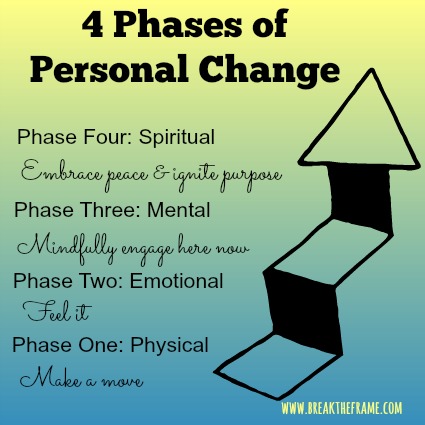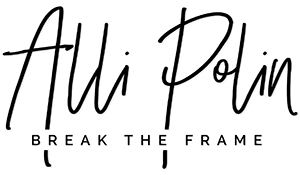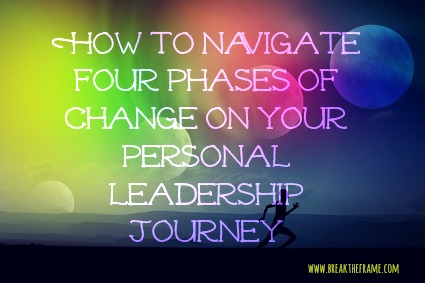True change has very little in common with the flick of a light switch (or winning an election). Yes, the light goes on, but it goes off just as easily – there is no stickiness or real shift. It’s just on, off, on, off. True change is much more like a journey. When you know the phases of change, you can bring awareness to where you’re currently stuck and make conscious choices to continue to move forward.
What if you’re instigating a career change or moving overseas or your organization was acquired? Even more relevant for so many now is moving forward when your candidate lost the election? Certainly, the answer is not to just roll over with passive acceptance. You can and must empower yourself to navigate your personal leadership journey through the change and use it as a catalyst for transformation.
[Tweet “Whether you’re the change instigator or receiver, you still go on a journey. Lead it.”]
I’ve been a change practitioner for over 20 years and strongly believe that there are things you can do to accelerate your personal change journey through each of the phases of change. Like all journeys, the change journey begins and ends with you moving. Body, heart, mind and soul all need to make the shift.
The Four Phases of Change on Your Personal Leadership Journey

Phase One: Physical
This is where it all starts – you make a move either by choice or a force outside of your control.
This is the easiest shift to make regardless of logistical complexity. In this phase, you’re moving from point A to point B.
My client moved from the suburbs to the City to double down on his commitment not only to his day job, but also his passion as a photographer of people in urban settings.
Another client’s company was acquired, and she had to leave her comfortable office she’d been working out of for years into a shared space.
Yet another had to reschedule countless meetings and immediately travel home to be with her father in the last days of his life.
Make the Leap Tip:
A to B can have a zillion details to juggle. Put them all on a checklist and work through it.
Phase Two: Emotional
Change is rarely easy even when you ace the logistics. You will likely feel a sense of loss regardless if you’re moving towards something wonderful or facing an unplanned tribulation.
There’s no need to push down the emotions that keep bubbling up during your change. You need to feel them and engage with them before you can let them go and move forward. It’s also essential to identify the core of the emotion. What is it about the change that’s leading to the most upset? Often, the heart of the emotional distress is masked or suppressed. Other times, the cause is clear. The bottom line is that smart leaders are unafraid to get to what’s underneath.
Coming face-to-face with emotion may make you feel weak or stupid or less masterful because it’s outside of your safety zone. So what? It’s essential for you to reframe that thought. Emotions are the heartbeat of life.
My client Jackie was a seasoned executive on her way from Senior Director to Vice President. We worked together to accelerate her success and promotion timeline.
A week prior to our scheduled call, Jackie found out that her son had an illness that would require ongoing care. True to form, she quickly put a plan in place but at the office was struggling to maintain her focus. She was also short tempered with her team which was out of character; they were driving her nuts. Jackie realized that her team didn’t dramatically shift their performance in a week but that something else was happening with her.
At the start of our session, Jackie asked if we could talk about something personal, her son. For our hour together she worked through the rawness of her son’s new reality and was able to begin to assimilate her feelings. Almost immediately she was able to take a deep breath and get back on track with her critical work projects too.
Jackie was not a corporate zombie, but a leader with a full life. In her effort to segment, she stopped herself from accepting her child’s health issue and was unable to remain on target at work. As I often tell clients, half a person can’t be a whole leader.
Make the Leap Tip:
Take a beat and find a trusted advisor, mentor, coach or friend and be with the emotions you’re experiencing – the whole crazy messy lot of them. Emotions indicate aliveness and a human rawness. If you don’t want to talk it through, write about your emotions in a journal. Getting to the root of your emotional distress puts you in control instead of at emotion’s whim. You choose how, but get the feelings on the table instead of packed way in a suitcase and stored in a closet only to be reopened days, weeks or months later.
Phase Three: Mental
Longing for the status quo of the past won’t bring it back. This is the phase where you make the mental leap from the old to the new. Unless you mindfully engage in your present circumstances, you’ll never fully cross the divide.
[Tweet “Imagine no longer straddling old and new but fully going all in.”]
After an acquisition, I had a client tell me in every single coaching session that the new company couldn’t hold a candle to the old organization. His headspace never left his old paradigm which left little room to embrace the new. He sat in the new building, had a new salary, new boss, and new colleagues, but all of that wasn’t enough for him to make the change from an employee of Company X to Company Z.
Here in my small community, there are other American families. Some of them order a huge number of groceries and cleaning supplies and have them shipped from the USA to Australia each month. I’ve decided that I live here and while it’s unfamiliar, I can make the leap to buying my necessities at the local store. It’s a small action that demonstrates a commitment to current circumstances.
Make the Leap Tip:
Bring a heightened awareness to when you’re choosing to live life and exercise your personal leadership like a temp. It’s through this awareness you’ll make dozens of new choices a day that enables you to make a lasting change. You owe it to your spouse, friends, family, colleagues, customers and your organization to be invested today.
[Tweet “What if your current circumstances weren’t temporary. What would change in you?”]
Phase Four: Spiritual
For some of you this phase may call forth religious spirituality, and for others, it’s more of a sense of connection to something bigger than you. Either way, in this phase of change you are stepping into a space that ultimately brings you a sense of peace and purpose.
There will always be things that are out of your control. Learn to let go (make note, this does not mean stop caring!)
Let go and accept where you are.
Let go and trust you will figure things out.
Let go and believe in what’s possible.
Let go of your constant comparisons.
Let go of what is keeping you handcuffed to the past.
Let go and ignite your purpose.
When you let go, it’s when you’re able to go all in. There’s no more resistance, but instead moving forward in your relationships with faith, hope, positivity and resilience.
However, let me be clear that letting go does not mean giving up. This phase is where the spark inside of you purposefully becomes a fire that ignites broader change.
[Tweet “Journeys are about more than a final destination You are meant to be where you are.”]
My client saw that his current organization, that he loved, was ultimately not committed to his success. The poor cultural fit limited his impact and crushed his spirit. He came to me after he found a new job (made the physical move), had mourned that his dream job wasn’t such a dream (emotional phase), and mentally shifted his mindset to creating success in his new industry. He also was on the edge of investing a large sum of money in his side hustle.
Through our work in this phase:
“I have to” became “I want.”
“I have no choice” became “I’ll keep an open mind.”
“It has to be this way” became “I will be okay no matter what.”
“Why did this happen” became “I can create my future.”
Did he make millions? No. Did he make the leap with both peace and possibility in his heart? You bet.
Make the Leap Tip:
Once you find peace with what is, and are no longer mourning the loss of the past, you can powerfully create your future.
Of course, there is always scaffolding present as well – not one of us makes a change in isolation. Hope, relationships, positivity and resilience are critical components to any successful change journey.
If you want to know more about how to put this model into practice in your life or organization, let’s connect.
You may also like 20 Change Management Lessons from working over 20 years in change.



Great post, Alli. A different slant on an age-old process, and excellent advice too!
Kind regards
John
Thanks, John! I know that there are many models floating out there. This is one I’ve been evolving for a while.
Alli
Great plan, Alli. As I read through the phases, a healthy thread weaves through each. We need to have healthy Spiritual, Mental, Emotional, and Physical ways to keep on a positive change path. Here is a healthy journey! Jon
I’m with you, Jon! Change can be stressful and we can get caught up in that stress. Here’s to a heathy journey ahead!
Best,
Alli
Hi Alli,
You did it again – asking the question I needed right now. In phase 3, you asked, “What if your current circumstances weren’t temporary. What would change in you?” As I read that, I realized that I have lagged behind on a volunteer project for an inner city school.
Why? Because my circumstances might be changing. Reading phase 3, I acknowledged that my circumstances are what they are. Sure, they may change for there is always change. So what? I can weave the volunteer project into the new circumstances. Leading in the present without factoring in “well maybe …” is what I need to change!
Will share.
Terri
Truly grateful for your feedback, Terri. That’s been an eye-opener for me in recent years too as I moved from Northern VA to the Australian Outback for an undetermined amount of time. Here’s to weaving a life of meaning now instead of missing out because of future change.
Best,
Alli
Alli,
I really like this process as it’s sensible, realistic, practical and a very useful tool. I might take issue with physical being first as I think any of them could be the catalyst for beginning the process. Mentally, you have to think about why change or what kind of change before making that first move physically or deciding whether or not you really want to make a change. Emotions can tell you if you’re happy, satisfied and content or the opposite which could also be a precipitating factor to jump start the process. I don’t think it matters too much which comes first, second, third or fourth. What matters because change is inevitable, it’s good to have a plan and a process for understanding and you’ve hit the nail on the head with these four steps. Thanks!
Gary,
I’m with you – change starts with a choice whether it’s made by you or for you. I do know people who have made mental leaps before the physical. Today I was speaking to a woman who’s moving her family around the world after 18 years. The way she explained it to me is that she’s done and staying is not an option, she has no choice but to move. In truth, she has a choice but has made the mental leap that she’s done and it’s time to go. Now for the physical move. Although, I’ll bet that the mental leaps will continue once she’s settled in her new location. It’s not a hard and fast flow, but cyclical, straight and a zig-zag process 🙂
Many thanks for your insights!!
Alli
Great post. Interesting to me in that you’ve numbered the four phrases – which of course gives some separation / identity to each one. But, for some people, numbers yield a list which provide a ranking of sorts and / or a stepwise plan of action. [Certainly not suggesting this was your intent; just suggesting that some are looking for ‘the key to the success’ – do this and then this … and you’ll reach the promise land! There were students of mine that never said but always were waiting for me to ‘tell them what to do so they would be successful, wealthy, and happy.’]
All four phrases need addressing and the dominating one I suggest will be a different one during the change effort. An obvious example for me at least: One cannot even conceive of a physical change because of a failure to recognize the blocking action of one of the other phases.
A couple of other thoughts:
– Even if you understand the ranked importance of the phases and focus on the dominant one, there should be the expectation that it’s highly likely this focus presently does not preclude its being the focus again in the future.
– Emotional phases do not always need to be negative. Positive emotions can serve as encouragement in the overall process OR as a harmful masking of needed attention to the other phases.
I do think that everyone has a key that unlocks their path forward. For some, as you mentioned their dominant phase to focus is mental and for others emotional and still others spiritual. When people tell me that they’re stuck on the physical, it’s usually another phase in which they’re actually stuck.
Also – great point on emotions. Life is filled with good and bad, highs and lows and we need to experience all of them.
As always, your insights make this richer – thank you!
Alli
Excellent post Alli! I always appreciate your articles. Sharing out to my community. Have an awesome day!
Sincerely appreciate all of your support and connection! Thank you for reading and sharing!
Alli
Hi Alli,
Unique approach in that so many don’t see change as this progression. Love the fact that you included a strong focus on emotional. Leaders often like to brush over this and yet those they lead are in it.
Great job!
Kate
Emotions in the workplace (and out) are often seen as weak. In truth, they’re a part of being human and impact our focus and effectiveness. I’ve worked with few leaders who allowed emotions to show up at the office. I don’t mean crying or screaming but more acknowleding that they’re not a worker bee but a person.
Years ago I worked for a woman who told another woman who had lost her child from SIDS that she should take a few days off and she expected her back on Monday – they needed her. This other woman lost her child and a long weekend wasn’t going to make that part of her life disappear. It was painful and heartbreaking and she still showed up through the healing. Unfortunately, this leader made it worse, not better by not recognizing that immediately moving on was not going to happen.
Thanks for all you do, Kate. Appreciate your insight.
Alli
Excellent post Alli!
Personal change impacts each of us so differently yet the four phases you describe seem practical and doable. I especially love: “Longing for the status quo of the past won’t bring it back.” I can’t tell you the number of times I think about how things could have been. But of course, change is the only constant in our lives.
Emotions are essential and need to be recognized. I have a friend who made a big career change and she is still bemoaning the fact that her old job gave her so much more flexibility. Yet I keep reminding her what a great opportunity the new job is affording her.
Thanks Alli and will definitely share!
Thanks for sharing your personal example. I think those sentiments will be familiar to many.
For so many people, their good opportunities are eclipsed by continuing to stand in the past when they’re living in the present.
Thanks, Terri!
Alli
I simply love how you addressed each and every important aspect of life when it comes to managing our way around change. As you say, embrace it before it embraces you…it is the surest way to be in control (or as much in control as possible). Leaning into the struggle is always safer and smarter than running away from it…I learned that much in the FBI Academy. We were taught to move toward the threat in order to increase safety. Stealthily, smartly, and cautiously…but the closer you get, the better you can see ways to overcome it.
You have me thinking, LaRae, about where I’m turning away from a threat instead of moving towards it with the confidence and courage that I can make it through. Fascinating to reframe that with the thought that moving towards is what increases safety. Grateful!
Alli